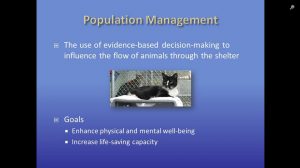Module 6: The Case of the Overwhelmed Shelter
Population Management
The ASV Guidelines state a MUST PRACTICE for every sheltering organization is active population management strategies that move pets to the best outcome in the shortest period of time to stay within capacity of care and prevent deterioration in physical and mental health. Population management is one of the foundations of shelter animal health and well-being and is based on an appreciation that capacity for care has limits in every organization.
Population Management is an active process of planning, on-going daily evaluation, and response to changing conditions. Effective population management requires a plan for intentionally managing each animal’s shelter stay to achieve the best outcome in the shortest amount of time. The goal is to maintain the population within the shelter’s capacity for care based on number of appropriate housing units and available staff. Loss of the shelter’s life-saving capacity is caused by ineffective population management rooted in unclear decision-making and obstructions to animal flow-through.
Another MUST PRACTICE according to the ASV Guidelines is the daily inspection of all animals in order to routinely evaluate and monitor adequacy of capacity and to identify needs for housing, care or service.
This daily inspection is called Population Rounds, a critical decision-making tool for pathway planning to achieve the best outcome for each animal. Every shelter must make a concerted effort to assign an outcome path to each dog and cat starting at intake and ensure efficient movement along that path to reduce LOS. A reduced LOS for each animal creates more housing space, provides more time for animals that take longer to reach a live release, results in enormous enhancements in the welfare of the animals, and reduces animal care days and animal care costs. Animals should not languish in the shelter because an outcome plan does not exist or is otherwise prevented from being implemented.
Population Rounds should be conducted by a Rounds Team, ideally consisting of the Shelter Manager, an animal care staff member, the Rescue Coordinator, the Adoptions Coordinator, and a member of the veterinary care team. The team approach is the most efficient and proven method to facilitate pathway planning and decision-making for each animal, and ensures that everyone is “on the same page” so there is no confusion or mistakes. The Team moves quickly from run to run and cage to cage without handling any animal. They review the kennel card information to identify the animal’s current status and the next step in the pathway so that no animals are “stuck” in the system without a plan tailored to their individual needs.
Effective population management rounds prevent delays or bottlenecks at critical flow-through points:
- Returning an animal to an owner
- Setting up transfer to a pet placement partner
- Scheduling pre-adoption health exams and spay/neuter surgery
- Scheduling euthanasia if that is the best outcome for the animal
The Population Rounds Team should address the following questions for each animal:
- Who are you?
- How are you?
- Are you where you should be?
- Do you need something today?
- Do you need something to be scheduled?
Watch This


